Google Nexus 9: Preliminary Findings
by Joshua Ho on November 3, 2014 1:00 PM ESTGPU Performance
Following along the same lines, we can also take a look at the GPU performance of Tegra13x in the Nexus 9. This really shouldn’t change too much though as the same GPU is used at the same maximum clock speed of 852 MHz. For those that are unfamiliar with the GPU in the Tegra K1, this is effectively a scaled-down version of their desktop Kepler GPUs.

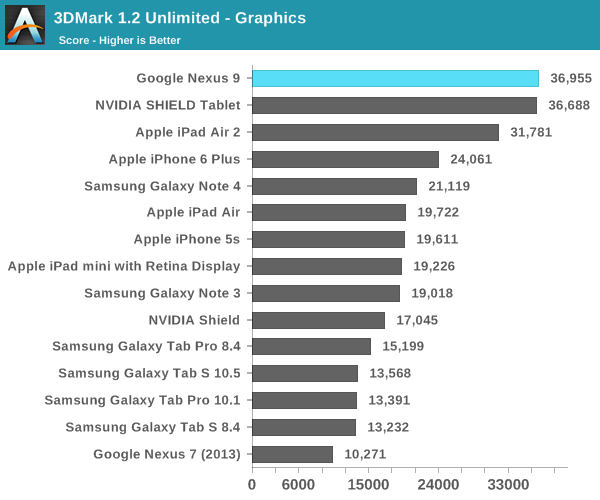
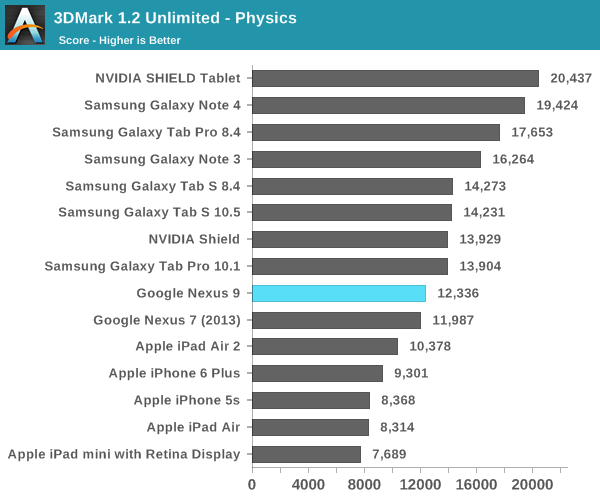


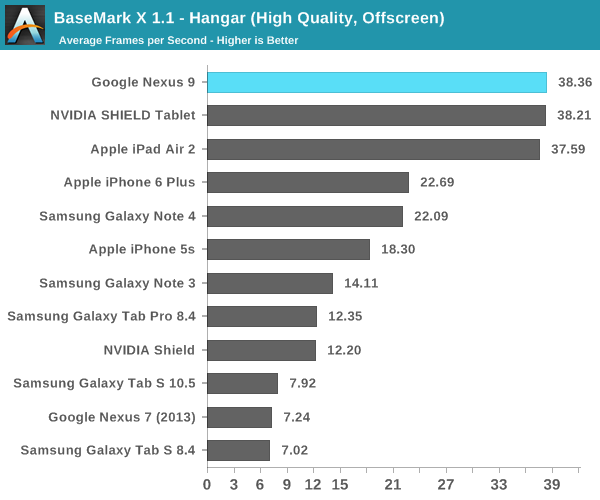
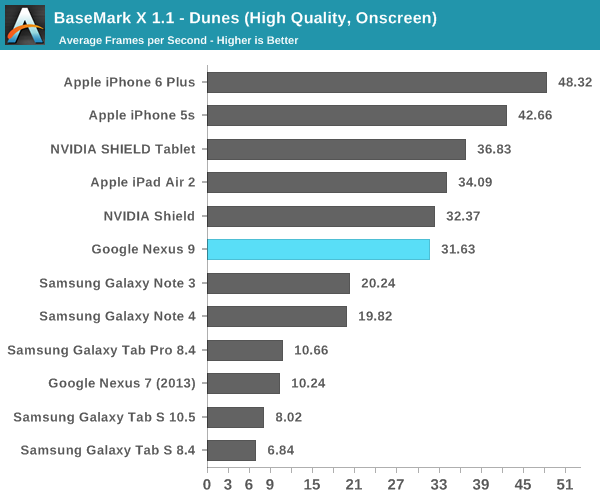
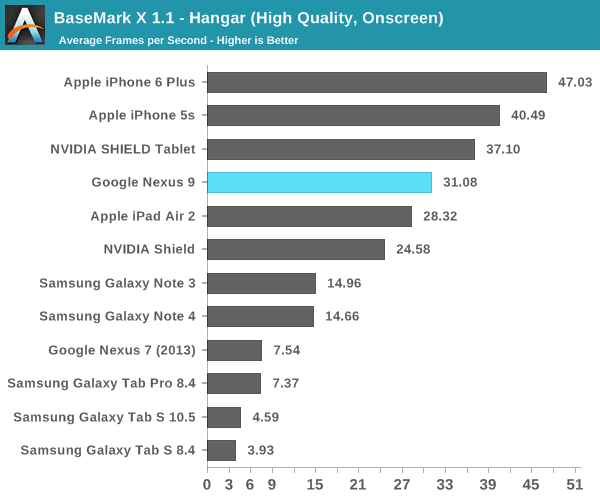
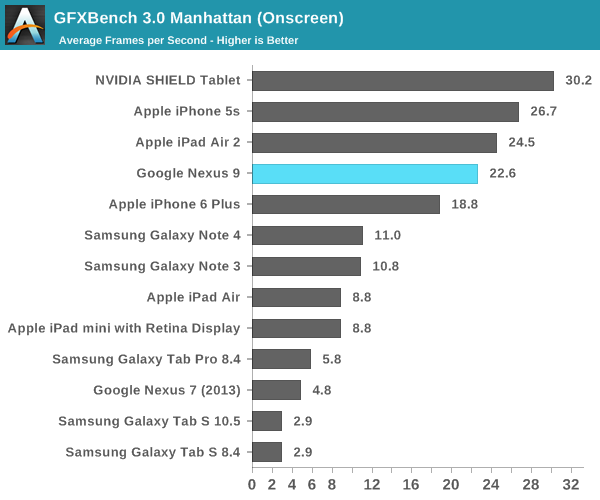
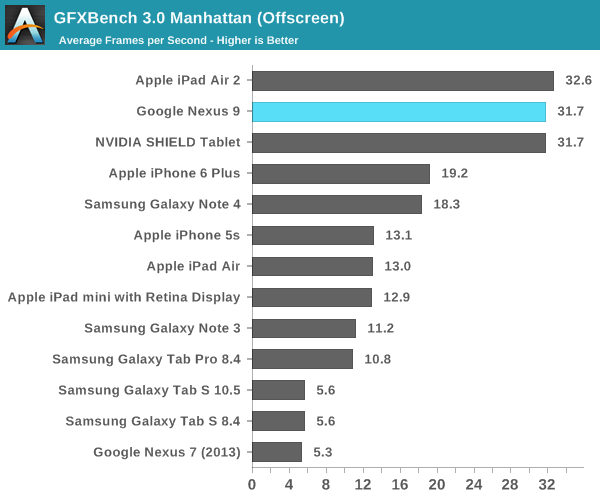
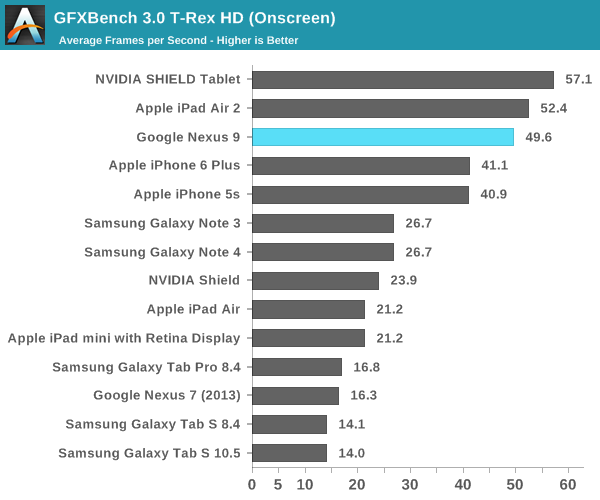

As one can see, the Nexus 9 is effectively equivalent to the SHIELD Tablet in GPU performance. The one anomaly here is 3DMark, which seems to be mostly due to differences in CPU. It's likely that this isn't representative of performance though, as 3DMark's physics test seems to perform better on CPU configurations that rely on larger numbers of cores and higher clock speeds. In the purer GPU tests like Basemark X and GFXBench performance across the board is effectively identical to the Cortex A15 variant of the Tegra K1.
Initial Conclusions
For the most part, the Nexus 9 shows some level of promise as a tablet. While Denver in NVIDIA’s Tegra K1 is a bit bimodal in performance, with sufficient optimization it has immense promise from a sheer performance aspect. While the SoC alone makes the Nexus 9 a fascinating device to look at, the rest of the package has a great deal of potential. The minimalistic design of the device, combined with good material design and stereo front-facing speakers really shows the high-end aspirations of this tablet. While we haven't received anything in the way of accessories, the keyboard folio case seems to be a way of pushing the tablet formfactor in a new direction. This is especially evident when seeing the focus on previous Nexus tablets which seemed to assume touch-only input.
While only a first look, there’s definitely a lot to be impressed by here. However, it will take a full review to really determine whether the Nexus 9 can compete with the iPad Air 2 as a tablet is more than just a function of battery life and SoC performance. In addition, it's hard to draw any real conclusions about this tablet quite yet as the software we received in no way represents a shipping build. Even if inactive, loggers and debug tools generally reduce performance, and it's likely that a great deal of optimization has occurred in the two months since this software build was completed. Once again, we haven't been able to get a newer build, but the full review should be done with shipping firmware.










146 Comments
View All Comments
shashiiishot2007 - Monday, November 3, 2014 - link
so the conclusion looks like nexus 9 cpu is weaker than ipad air 2 but gpu is equal on the ipad air 2. battery life cannot be compared to ipad air 2 since anandtech still did not review it.chizow - Monday, November 3, 2014 - link
Yep, but keep in mind Apple is leveraging 20nm and 1Bn extra transistors on their A8X, which almost perfectly translates into 50% more CPU (1 extra core from 2 in A8) and 50% more GPU (2 extra Rogue GPU clusters from 4 in A8). So the disparity in CPU perf is easy to explain in any case.I think the Denver K1 did better than expected given early benchmarks had it losing to A8X virtually across the board (except for single-threaded).
Also, you can compare battery life because this Preview is basically an iPad Air 2 preview too as it has all the iPad 2 Air data points including battery life. That's probably the most impressive aspect actually, Google/Nvidia was able to beat iPad Air 2 battery life in a smaller form factor.
blackcrayon - Monday, November 3, 2014 - link
Do we know what the relative sizes of the batteries are? Obviously the iPad is larger but is also thinner.chizow - Monday, November 3, 2014 - link
According to ZD the iPad Air 2's battery is 27.62Wh (actually smaller than iPad Air) while the Nexus 9's battery is 25.46Wh, so yeah while the Air has the bigger screen, it also has the bigger battery and benefit of 20nm on its SoC.I guess it is pretty safe at this point to say, all the rumors about Tegra K1 not being able to do well in a thin tablet form factor while retaining its performance were wholly unfounded. Certainly bodes well for Erista with 20nm and Maxwell next year!
solipsism - Monday, November 3, 2014 - link
It's weird to say it's a smaller form factor to claim the battery life is therefore impressive, when the display size difference is double that of the battery capacity difference.kron123456789 - Monday, November 3, 2014 - link
"This build of Android clearly has AArch64 active, which means that we should be able to directly compare the Nexus 9 to the iPad Air 2 for performance." — Um, no. System is using AArch64, but apps aren't.frostyfiredude - Monday, November 3, 2014 - link
Native third party applications won't be, but the included applications should be for the most part and so will the applications purely run on ART bytecode. Granted, benchmarks will be the most likely to be native and still AARCH32, but some of the tests will be quite fair.kron123456789 - Monday, November 3, 2014 - link
Preinstalled Google Apps maybe AArch64, but all third-party applications are AArch32. ART bytecode doesn't make them 64 bit. BTW, there is no Dalvik in Android 5, so all apps are purely run on ART.toyotabedzrock - Monday, November 3, 2014 - link
I think the android Dev blog said art would compile any non native apps to aarch64 automatically.Samus - Monday, November 3, 2014 - link
They ditched Dalvik? wow, there goes like half of the Play Store ;)